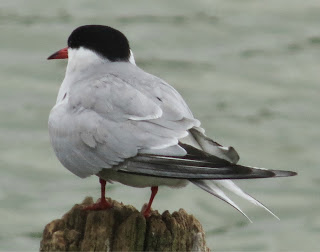Other migrant visitors include these flycatchers. The first a Pied Flycatcher, seen at Penyschant, near Conwy, and well worth a visit for a quiet few hours. These were seen flying in pairs at high speed around and through trees, the female playing 'catch me if you can' with the male. The second is a Spotted Flycatcher, seen at Pagham Harbour, darting from it's branch to hover almost like a hummingbird as it plucked flies from the air, and then back to it's perch.
Other birds are resident all year round, but still make a pleasing sight. This a Goldfinch rummaging through the grass for seeds.
The grey Heron is also a resident, and a firm favourite of mine. This one trying his best to do a 'Darth Vader' impression early one morning.Spring of course means one thing: lots of squeaking, squawking, quacking, and flapping of wings. This particularly indiscreet couple were flagrantly performing at Arundel WWT.
Obviously they weren't the only ones as all around the grounds there were signs of new life. Goslings, Coot and Moorhen chicks. One proud Mallard Mum even took her chicks for a tour of one of the hides
And if you think it's just the birds at it, here's some lambs too!
And as the month has moved on, we've started getting Summer visitors too, Swallow, Swifts and Martins joining the throng. This Swallow was also inspecting the inside of a bird hide, making for an easy photo, while the following Swift was much harder work, needing dozens of shots to get one passable view.
A trip to the Great Orme was worth all the Bank-holiday traffic problems when it yielded Chough's, an uncommon member of the corvid family, related to rooks, crows etc.
And sea-level has provided some new birds too, this a Common Tern, posing on a fence post at one of the pools at Arundel WWT.
Arundel also provided this shy little Mandarin duck, tucked away in a wooded area. Is this an escapee from the 'captive' part of WWT, or a genuine wild bird? Don't know! Either way, it was a very pleasant sight.
Nearer to home, RSPB Burton Mere Wetlands also delights. This Wood Sandpiper dropped in for a morning visit, causing quite a stir - it should have already been up in it's Artic breeding grounds, another casualty of the late spring.
Also at Burton Mere, this Willow Warbler delighted with some lovely views, including this one with flies caught in it's beak.
Again at Burton Mere, we were treated to a visit by a stunning female Marsh Harrier. Unfortunately the Black-headed Gulls took exception to her presence, and mobbed her across the reserve.
And finally, I finish again with another common bird, but I couldn't resist the pose of this Chaffinch, this taken at Frodsham Marshes.





































